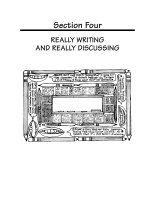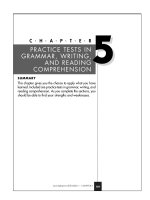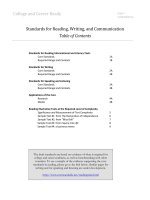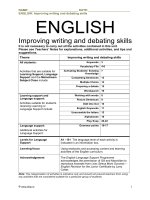Visual Writing and Cereal
Bạn đang xem bản rút gọn của tài liệu. Xem và tải ngay bản đầy đủ của tài liệu tại đây (183.11 KB, 22 trang )
cereal
is a popular food whose
packaging distinguishes it from all
other breakfast foods. Think about it.
Have you ever placed an egg carton on
the table, so that you could read its
information while eating scrambled
eggs? Of course not! But cereal boxes,
that’s another subject. At one time or
another, all of us have scanned or read
the panels on a cereal box while
munching on a crunchy bowl of flakes
or puffs. As if browsing through a
magazine, we noticed the colorful pic-
tures on the front and back panels,
read interesting facts on the informa-
tive side panels, enjoyed . . . hey wait!
visual writing and cereal
19
three
Visual Writing
and Cereal
chapter
I’ve been braintalking! This last sentence is like the braintalk introduced in
Chapter Two. It sparked my left brain’s desire to graphically organize a word
map that depicts the subject of cereal boxes and their characteristics:
the various kinds of visual writing
In Chapter Two you completed a word web. To get a clearer picture of what
visual writing is all about, you need to understand that visual writing comes
in many shapes and sizes, and the shapes and sizes you should use depend on
what is required by essay topics, also known as essay prompts. They are called
prompts because they prompt you to think about a topic.
The next section in this chapter presents and explains the variety of visu-
al maps. It includes essay prompts with examples of visual maps constructed
for the prompts. Take time to understand each visual map presented, because
you’ll need them to complete the activities that follow. While the sample
visual maps are very different from one another, they all relate to the same
subject: cereal.
The samples and activities in this chapter will prepare you for the more
complex activities that follow, which ultimately prepare you for the real essay
tests that will be thrown onto your desk, much like the gadgets and widgets
discussed in Chapter One. Remember: NASA engineers faced their problem
by working with random miscellany to which they added thought, logic, pat-
tern, discovery, and solution. Consider yourself a writing engineer who uses
visual maps to graphically organize solutions for every essay challenge
visual
writing
20
whether descriptive, narrative, informative, or persuasive. The types you’ll
use most often are:
■
Venn Diagrams
■
Hierarchical Maps
■
Sequential Charts
■
Cyclical Maps
■
Wo r d We b s
■
Plot Diagrams
the Venn diagram
The Venn diagram is a conceptual map consisting of two overlapping cir-
cles that create three sections.
By writing words and phrases into the appropriate section, writers see the
similarities and differences between an essay’s stated topics.
The Venn diagram is very useful when you are asked to compare and con-
trast two concepts, two people, or different customs.
Essay prompts signal the usefulness of Venn diagrams when they include
phrases like:
■
compare and contrast
■
choose between
■
distinguish between
■
decide between
visual writing and cereal
21
NASA engineers faced their challenge by
working with random miscellany to which
they added thought, logic, pattern, discov-
ery, and solution. Consider yourself a writ-
ing engineer . . .
Venn diagram
Cereal Essay Prompt #1: You are asked to decide the menu for your
club’s end-of-year breakfast meeting: cereal or bacon and eggs?
Convince your fellow members that your choice of breakfast is the
best choice. (Persuasion)
A Venn diagram becomes very useful when asked to distinguish between two
of anything! Its overlapping circles help you to see similarities and differences.
Depending on your knowledge base, you might add specific vitamins and
minerals to the Venn diagram shown. Whatever you add, it is pretty clear that
there is very little similarity. The choice is now up to you. Do you argue in
favor of the healthy and easily prepared cereal breakfast? Or do you persuade
your reader that the aromatic, delicious bacon and egg breakfast is worth the
added difficulty of its preparation? Whatever you decide, the Venn diagram
visual
writing
22
organized your ideas. It has also set a stage to showcase your writer’s voice, when
you write your essay. (More about the rubric called Voice in Chapter Five.)
hierarchical map
A hierarchical map is a conceptual map that deals with main concepts and
subconcepts.
A hierarchical map starts with a shape—for example, a rectangle—in
which a main concept or category is written. Analysis of the concepts pro-
duces subconcepts, subcategories, sublevels, etc. The word widgets for these
subconcepts are written within shapes comparable to and beneath the main
concept, establishing the hierarchy or pecking order.
Essay prompts signal the usefulness of hierarchical maps when they include
words like:
■
analyze
■
classify
■
divide
■
categorize
hierarchical map
Cereal Essay Prompt #2: You are given random cereal boxes. Using
visual writing and cereal
23
Breakfast cereal will keep us all heart healthy and help us win the
battle of the bulge!
Who wants to settle for a soggy bowl of cereal when you can enjoy
delectably fried eggs served with delicious-tasting, crisply fried
bacon? Come on. You only live once.
The Venn diagram has set a stage to showcase your writer’s voice
when you write your essay.
information gathered from the boxes, identify the nutritional bene-
fits derived from eating cereal for breakfast. (Informative)
A hierarchical map suits this essay. You start with a main concept, like “Cereal
Breakfast Nutrition,” and chart subconcepts beneath it as they are identified,
i.e., milk and corn flakes, vitamins, protein, etc.
sequential chart
A sequential chart is a conceptual map that charts the sequence of specific
events using a linear (resembling a straight line) pattern of organization.
Charting events on a timeline is the perfect example of a sequential chart.
Essays will sometimes ask you to write about the cause and effect of a par-
ticular event, a battle for example. When they do, sequential charts are the
maps to use.
Essay prompts signal the usefulness of sequential charts when they include
words like:
■
show, describe, or explain the . . .
visual
writing
24
■
cause and effect
■
chronological order
■
sequence
■
events
sequential chart
Cereal Essay Prompt #3: Describe what happens to a bowl of cereal that
sits too long. (Description)
A sequential chart is perfect for this essay because it clearly asks the
writer to describe a sequence of events. Here are two versions of a sequen-
tial chart to show you that you can add your brain’s artistic personality to
your sequential charts.
visual writing and cereal
25
cyclical map
A cyclical map is constructed using a circle or cyclical shape. It is most use-
ful to represent events that are part of a continuous cycle, for example, day
turns to night, which turns into day, etc.
Any time an essay directs you to write about a topic that involves a con-
tinuous process or sequence, you should create a cyclical map, which illus-
trates the continuous or cyclical nature of that process.
Circular or clock-like by design, cyclical maps help you recall the details,
whether sequentially, hourly, seasonally, etc.
Essay prompts signal the usefulness of cyclical maps when they include
words like:
■
continuous
■
cyclical
■
process of
■
life of
visual
writing
26









